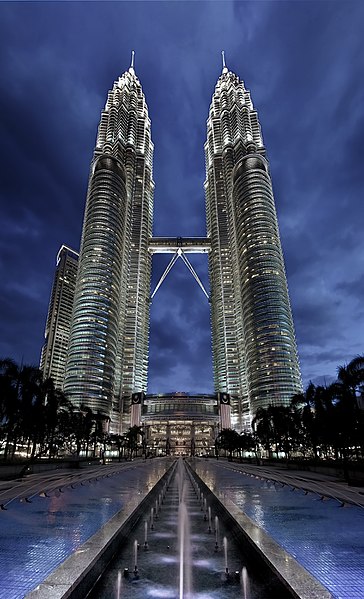Difference between revisions of "About Malaysia"
(Created page with "{{#eimage:http://upload.wikimedia.org/wikipedia/commons/thumb/8/85/Petronas_Panorama_II.jpg/364px-Petronas_Panorama_II.jpg|410x579px|thumb|'''The Petronas Twin Towers, Kuala L...") |
|||
| Line 2: | Line 2: | ||
During the late 18th and 19th centuries, Great Britain established colonies and protectorates in the area of current [[Malaysia]]; these were occupied by [[Japan]] from 1942 to 1945. In 1948, the British-ruled territories on the Malay Peninsula except [[Singapore]] formed the Federation of Malaya, which became independent in 1957. [[Malaysia]] was formed in 1963 when the former British colonies of [[Singapore]], as well as Sabah and Sarawak on the northern coast of Borneo, joined the Federation. The first several years of the country's independence were marred by a communist insurgency, Indonesian confrontation with [[Malaysia]], Philippine claims to Sabah, and [[Singapore]]'s withdrawal in 1965. During the 22-year term of Prime Minister MAHATHIR bin Mohamad (1981-2003), [[Malaysia]] was successful in diversifying its economy from dependence on exports of raw materials to the development of manufacturing, services, and tourism. Prime Minister Mohamed NAJIB bin Abdul Razak (in office since April 2009) has continued these pro-business [[policies]] and has introduced some civil reforms. | During the late 18th and 19th centuries, Great Britain established colonies and protectorates in the area of current [[Malaysia]]; these were occupied by [[Japan]] from 1942 to 1945. In 1948, the British-ruled territories on the Malay Peninsula except [[Singapore]] formed the Federation of Malaya, which became independent in 1957. [[Malaysia]] was formed in 1963 when the former British colonies of [[Singapore]], as well as Sabah and Sarawak on the northern coast of Borneo, joined the Federation. The first several years of the country's independence were marred by a communist insurgency, Indonesian confrontation with [[Malaysia]], Philippine claims to Sabah, and [[Singapore]]'s withdrawal in 1965. During the 22-year term of Prime Minister MAHATHIR bin Mohamad (1981-2003), [[Malaysia]] was successful in diversifying its economy from dependence on exports of raw materials to the development of manufacturing, services, and tourism. Prime Minister Mohamed NAJIB bin Abdul Razak (in office since April 2009) has continued these pro-business [[policies]] and has introduced some civil reforms. | ||
| − | |||
| − | |||
Back to [[Adopting from Malaysia]] | Back to [[Adopting from Malaysia]] | ||
Latest revision as of 12:30, 12 July 2021
During the late 18th and 19th centuries, Great Britain established colonies and protectorates in the area of current Malaysia; these were occupied by Japan from 1942 to 1945. In 1948, the British-ruled territories on the Malay Peninsula except Singapore formed the Federation of Malaya, which became independent in 1957. Malaysia was formed in 1963 when the former British colonies of Singapore, as well as Sabah and Sarawak on the northern coast of Borneo, joined the Federation. The first several years of the country's independence were marred by a communist insurgency, Indonesian confrontation with Malaysia, Philippine claims to Sabah, and Singapore's withdrawal in 1965. During the 22-year term of Prime Minister MAHATHIR bin Mohamad (1981-2003), Malaysia was successful in diversifying its economy from dependence on exports of raw materials to the development of manufacturing, services, and tourism. Prime Minister Mohamed NAJIB bin Abdul Razak (in office since April 2009) has continued these pro-business policies and has introduced some civil reforms.
Back to Adopting from Malaysia
